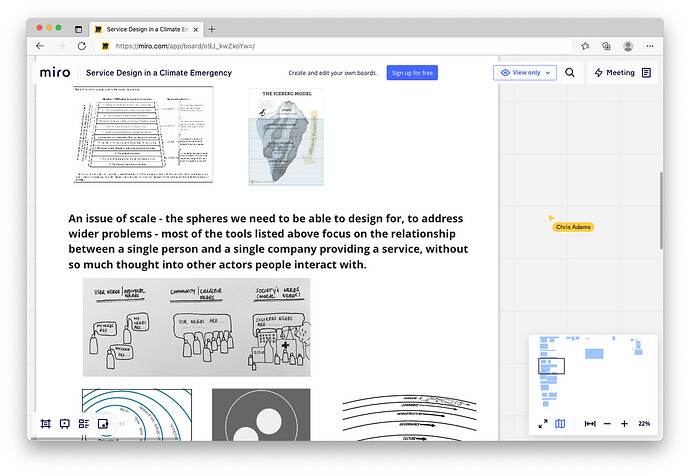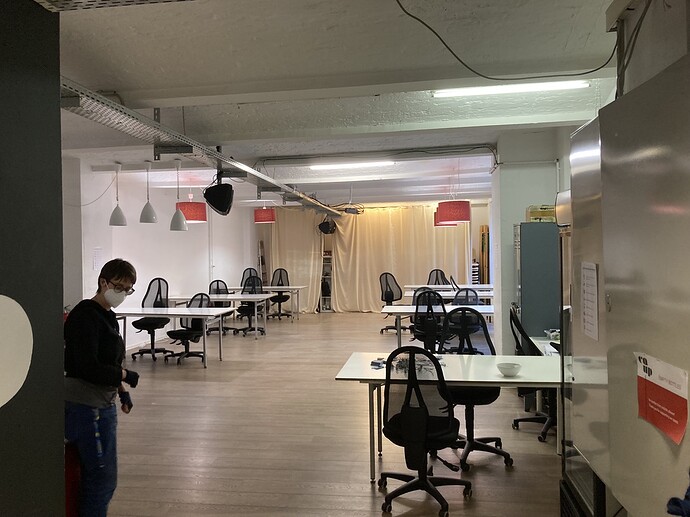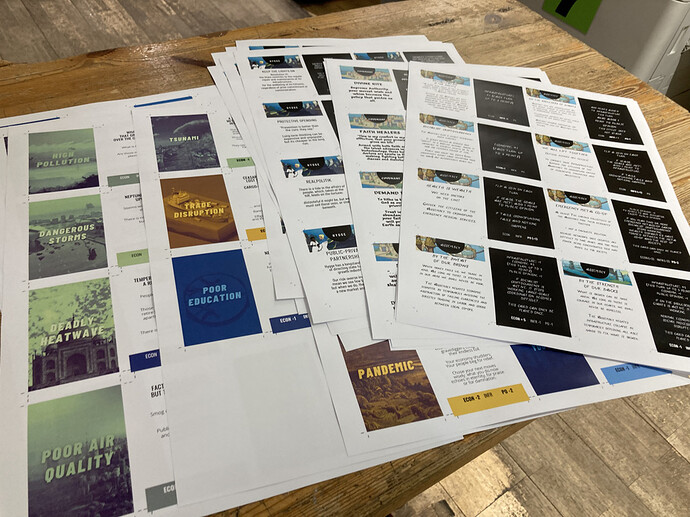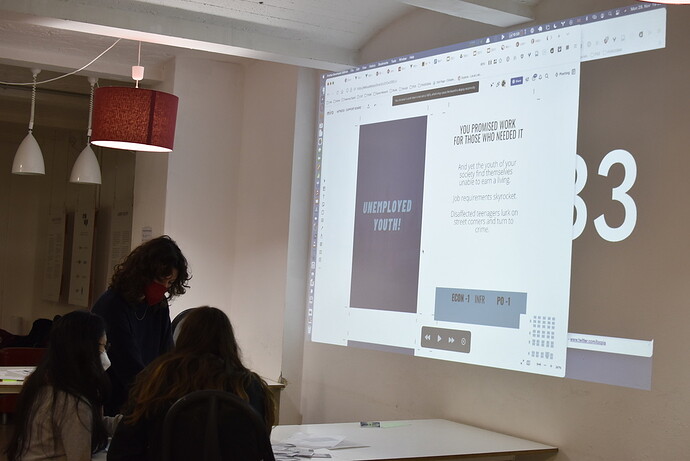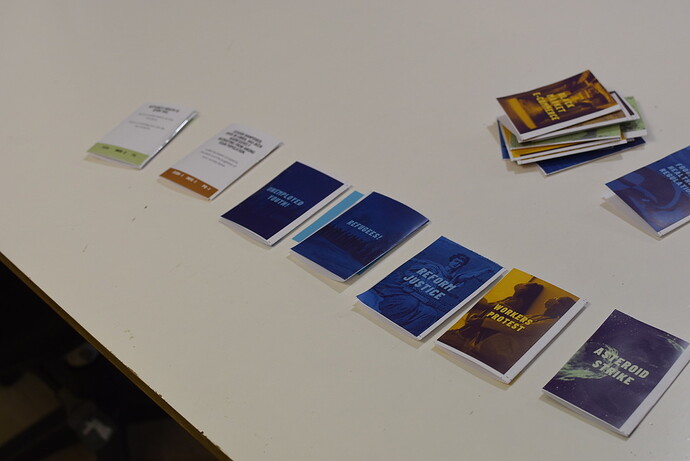Hi folks.
I helped run a play testing session of the Witness game this week in Berlin on Nov 29th, as a companion to the virtual event run by the EdgeRyders. Here’s my writeup.
How I got involved
Back in 2019, Kathryn Hing and I ran Service Design in an Climate Emergency, a workshop as part the Edgeryders’s festival, to explore some of the systemic issues around incorporating an awareness of climate into disciplines like Service Design.
One of the reasons for this is that Service Design techniques are increasingly used as part of transformation projects for both private and public sector services, and this perspective is probably best summarised by a quote from Matt Edgar, service director at NHSX and NHS England:
Most of government is mostly service design most of the time.
This quote expanded in a fairly well known blog post in digital public sector circles, and worth a read.
Anyway, you can see some resources elsewhere on this site, along with a cool visual summary of the day:
Also, one of the take-aways from the day was that people in their current practice didn’t really have the language to effectively talk about the challenges climate change presents in a way that would let them prioritise one form of climate action over another, or even be able to talk about trade-offs on climate versus other priorities they might have. Unsurprisingly, it was pretty hard to have a useful discussion within the confines of how they were employed to work as services designers, and ones frequently in private sector organisations.
We ended up dropping a number of images onto Miro board before and after the event, making it available to attendees (you can have a look for yourself if you fancy).
While the event was interesting, we didn’t really try to follow up with future sessions, until earlier this year.
Fast forward to 2021, and getting nerd sniped
Earlier this year, I got totally nerd sniped by @nadia with this topic in the internet of humans forum here, and after I found a willing co-conspirator, ended up working on organising an event in Witness.
I mean, if the confines of working as a service designer in late stage capitalism made if hard to talk about effective action, perhaps exploring these under different economic systems might help?
Prepping for the event
Where we ran it:
We ended up using co-up, a well known community space in the open source community in Berlin. I’ve been running going to and running events there since 2015, and we got it for free (it was the first event they had running in their venue since the pandemic began). It normally has space for ~70 people, but during the pandemic, the maximum capacity with the windows and the rest, was less than 20. You can see it below, in co-working configuration.
Getting word out
I help organise climateAction.tech - an online community of about 5000 technologists, and the weeks up to the event, we initially piggy backed off the original eventbrite and edgeryders promo to include links to the event in the weekly CAT (climateAction.tech) newsletter.
We did some direct promo as well, but we largely leaned on the newsletter for reaching people, and the social media channels we had available to us.
A couple of weeks before the event, we realised that piggy backing off the original edgeryder event made it hard to see if we had signups, or communicate with attendees. We ended up creating a separate eventbrite
On the Friday 26th before the event on 29th Nov, we had 17 signups.
Arranging props for play testing
Unfortunately for a card game, the UPS shipment that was sent from Belgium in good time for us to use during the day ended up not making it to us.
So, instead, on Monday, I ended up printing and cutting out card decks for a significant chunk of the day to use for the evening, at a nearby print shop. On the upside, this did at least afford a chance to read the cards, and understand the various effects in more detail:
Printing out the cards and cutting them into two packs of cards with guillotines, and then sticking them together took most of the morning, and a chunk of the afternoon. I think if I was to do this again, I might think about seeing if there was a way I could upload the PDFs to Moo.com, or similar, to have them as print-on-demand options closer to the event.
Play testing on the day virtually
Both Katrin and I had a chance to join the virtual event at lunch time on Monday - this was really useful before the event, and I don’t think we would have felt anywhere near as comfortable running the event in the evening without attending it, and I’d go so far as to require something like this for prospective hosts in future.
In the middle of a pandemic, seeing the game open with the pandemic card made us really, hope we wouldn’t lead with it, as it seemed to negate a bunch of work done already to establish a sense of distance from where we are now, economcally and politically.
Also, running through the audio intro as a player was helpful - once we had an idea of what it was like to be a player, it was much easier to facilitate with that in mind in the evening.
Running the event
While the sign below shows this as a 2G event, we ended up running it as a 2G+ (everyone needed negative tests, plus recovery or vaccine)
Of the 17 sign ups, 8 turned up in total, including us, so (60% drop out rate)
These included:
- Business students from the Mondragon cooperative in the Basque Country - they were visiting Berlin for new ideas, and well. this was an event of new ideas…
- Analysts working on the German Federal Hydrogen Strategy
- Folks at TU Berlin, designing their own game for exploring the circular economy (within sustainability circles, I’ve learned that there’s a bit of pushback against the circular economy concept, because it’s seen as a way to avoid questioning the idea of economic growth as a societal goal)
- Designers and developers looking for new climate themed projects or jobs
Our layout
To begin with, we had considered totall changing the layout for the space, but with 17 signups, and the whole pandemic set up, we ended up following the plan below:
1 - Opened with the audio intro, after a little bit of introduction using the slide deck at - bit.ly/witness-bln-2021
2- Have 6 tables set aside - 2 tables per distrikt (so people in the same distrikts afterwards can compare their responses to events after the game)
- 2x hygge
- 2x assembly
- 2 covenant
Each table had the cards and the A4 1 pager explaining them. The idea here was that attendees could read about the different distrikts, then decide where to ‘migrate to’.
On each table, we had a couple of A4 sheets listing the possible policy response cards, and we asked players not to turn over cards until they had actually played any card.
Some ended up laying out the cards like so - so they could see which cards were in play, and which were still available
This wasn’t universal, but seemed interesting enough to share, as I hadn’t thought of the portfolio of responses for a distrikt being laid out like this:
What our distrikts faced
Because we had a number of groups, but not so many event cards, we laid out the cards in a miro board, and used a projector to show everyone what the event cards meant:
This helped us explain the cards to the multiple groups. After explaining the cards, we set a timer of 5 minutes for each group to discuss their distrikt’s response, before choosing a card, and tracking how many points were left.
This was a bit of an executive decision on our part - to be honest, we were a bit worried about getting stuck with an event like pandemic like the lunchtime playtest. In that case, we were both Hygge, and spending the game time, talking about how something like Europe might would handle a pandemic didn’t seem very far from our day to day.
We had small groups, and being able to explore how the different distrikts respond differently over time to different events seemed more in keeping with the idea of the event. The players seemed to respond positively to the tension introduced by the timer, and meant that we had quite a high chance of seeing events unfold.
We also figured in a real policy context, you’re making decisions with incomplete information, often in a hurry, so it was easy enough to work into the game.
All in all, we lasted 7 rounds, which ran to a little over an hour.
These were the events we dealt with.
- High pollution
- Brain Drain
- Youth Unemployment - this killed off Hygge. We had no idea distrikts could die so quickly!
- Refugees - because we had such small groups, rather than having a group sit out the game, and we worked the migrant train into the in-game narrative. We split the former hyggians into the two remaining distrikts, as refugees from the fallen distrikt.
- Reform Justice - the players were pleasantly surprised to see positive cards appear - felt more hopeful
- Worker protest - this killed off the Covenant last players
- Asteroid Strike - because the groups were all enjoying the story, we checked to see what came next for the surviving distrikt, the Assembly. This event would have killed them off too.
Key learning points from playing the game
-
The feedback was broadly positive, and even though Katrin and I weren’t too experienced, it was still a fun game - the world seemed rich, and the non-Hyiggian players spoke about how much they enjoyed reading the different policy ideas for card.
-
Almost all the players struggled to understand the NGI/ internet technology link suggested in the event material - it seemed entirely about economics and politics.
-
People wanted to share their post game experiences, and see what the others were doing - we didn’t have a good way to recap this, and even after the game discussing what the groups did was hard.
-
Players wanted to see how other groups were responding to the same event, and it felt like this wasn’t supported well. With no interaction between the distrikts, or real incentive to see how they are doing, it can feel like 3 separate games, and if you’re one distrikt, part of the appeal seems to be comparing how you handle a crisis with how another one does. Having a mechanism to capture between turns which of the distrikt’s seems best prepared to face future events might prompt this kind of interaction, without messing with the game mechanics - perhaps a quick poll, or timebox for discussion.
-
In its card game guise, it’s really hard to see policy interventions stack up over time if you don’t have easy access to the relevant pages on netlify, as there is no visual cue on the printed cards. We couldn’t keep track of this from turn to turn properly.
Further written feedback from Katrin, based on transcribing some of the notes
- Points: it was not 100% clear to us how the points-system worked; especially with special cards that had an effect on every further turn of the game we were not sure if we played and calculated them correctly
- Can one card be played twice? Because you already know how many points you’ll get if you play it again…
- Is it a maximum of 5 points or can you collect more than 5?
- Some statistics / hard facts about each city/ideology would have been appreciated to get into the game and mindset more easily
- The Digital tech angle was not so present; participants expected a stronger focus on it though
- Unexpected things were happening: this was a great learning for how politics and policy making work and was also a lot of fun
- We migrated one group to another city after they lost at 0 points; this was a really well received, and kept the game going for everyone
- Wording of cards: the wording of all cards (and also of the game in general) should be much more accessible; many concepts that people don’t understand are on it with no explanation; and an old/high-level vocabulary is used that is very hard to understand for Non-English native speakers.
More info
See the photos in the witness google drive folder, along with captured written feedback from players
https://drive.google.com/drive/folders/1tg-1hZOs7-va0vYrNXNrjYZc3l5xNQea?usp=sharing
See the google doc with some of Nadia’s question prompts earlier this week:
Hope that helps! I’m happy to answer questions, and I’ll try to answer them promptly, but I can’t promise I’ll get to them all quickly.

